
Scutelleridae is a family of true bugs. They are commonly known as jewel bugs or metallic shield bugs due to their often brilliant coloration. They are also known as shield-backed bugs due to the enlargement of the thoracic scutellum into a continuous shield over the abdomen and wings. This latter characteristic distinguishes them from most other families within Heteroptera, and may lead to misidentification as a beetle rather than a bug. These insects feed on plant juices from a variety of different species, including some commercial crops. Closely related to stink bugs, they may also produce an offensive odour when disturbed. There are around 450 species worldwide.

Eristalinus taeniops is a species of hoverfly, also known as the band-eyed drone fly.

A wasp is any insect of the narrow-waisted suborder Apocrita of the order Hymenoptera which is neither a bee nor an ant; this excludes the broad-waisted sawflies (Symphyta), which look somewhat like wasps, but are in a separate suborder. The wasps do not constitute a clade, a complete natural group with a single ancestor, as bees and ants are deeply nested within the wasps, having evolved from wasp ancestors. Wasps that are members of the clade Aculeata can sting their prey.

Lygus pratensis is a species of plant bug belonging to the family Miridae.

Hedychrum rutilans is a species of cuckoo wasps. The species occurs primarily in Austria, Italy, Bulgaria, Greece, France, Poland, Portugal, Spain, Switzerland and in North Africa. The head and thorax are metallic green with red spots, while the abdomen is red. The color is more green and partially golden in the male and more extensively golden-red in the female. The body is somewhat hairy.
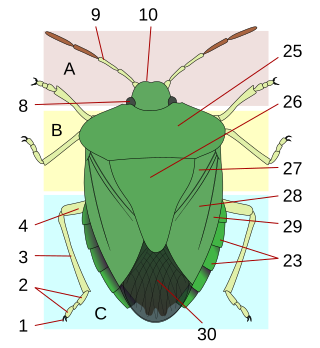
The thorax is the midsection (tagma) of the hexapod body. It holds the head, legs, wings and abdomen. It is also called mesosoma or cephalothorax in other arthropods.
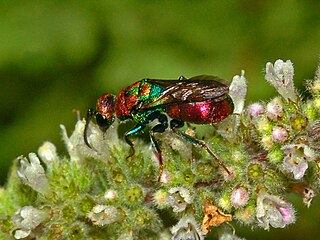
Hedychrum is a large genus of cuckoo wasps. With roughly 150 species, it is the second largest genus in the family; most species are from the Palaearctic, but they can be found in the Oriental, Afrotropical, Nearctic, and Neotropical regions. Their hosts are typically from the subfamily Philanthinae.
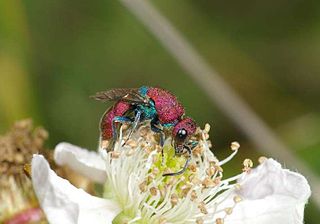
Chrysura cuprea is a species of cuckoo wasps.

Chrysis scutellaris is a species of cuckoo wasps.

Pseudomalus auratus is a species of cuckoo wasp.

Katamenes arbustorum is a species of potter wasp in the subfamily Eumeninae of the family Vespidae.

Larra anathema is a species of parasitoid wasps belonging to the family Crabronidae. It is the type species of the genus Larra.
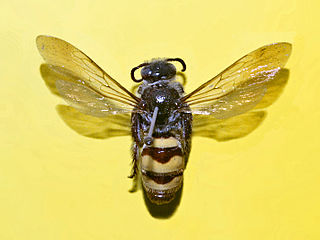
Dielis trifasciata, also known as the three-banded scoliid wasp is a species of the family Scoliidae.
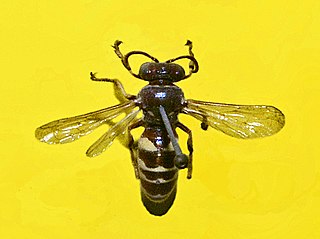
Bembecinus tridens is a species of sand wasps belonging to the family Crabronidae.

Polistes bischoffi is a species of paper wasps belonging to the family Vespidae.

Crabro cribrarius, common name slender bodied digger wasp, is a species of wasp of the family Crabronidae.
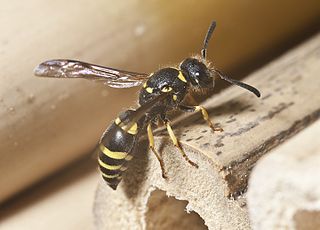
Ancistrocerus nigricornis is a species of potter wasp.

Argogorytes mystaceus is a species of solitary wasp in the family Crabronidae.
Sapyga louisi is a species of club-horned wasp in the family Sapygidae. Adults feed from flowers and larvae are kleptoparasites of leaf cutter bee larvae, including those of Heriades carinata.

Trichrysis cyanea is a species of cuckoo wasps, insects in the family Chrysididae.




















